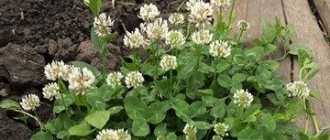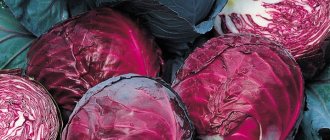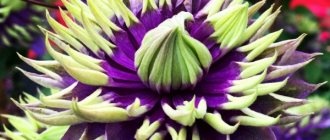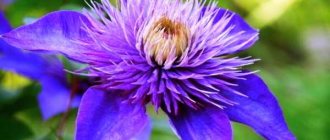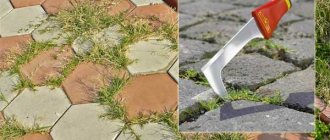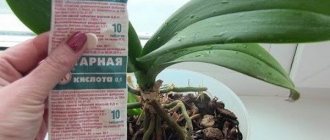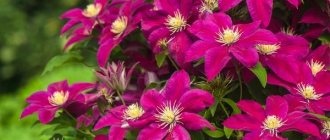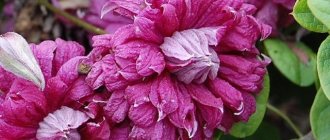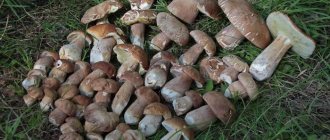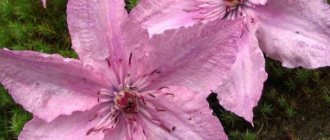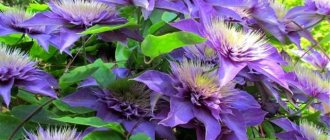Characteristics of small-flowered clematis stinging
Eastern stinging clematis is a vine-like shrub. The height of the plant can reach 4-5 m, the width of the bush is on average 3-4 m.
The leaves of clematis pungent are small, slightly pointed at the end. The color of the leaf blade is quite dark. The flowers are also small, their diameter is only 2-3 cm. They are white and resemble small stars in their appearance. Clematis stinging blooms profusely, each bush produces about 300-400 flowers. Due to the fact that the flowers are collected in large paniculate inflorescences, during flowering clematis takes on a very lush appearance. Sometimes there are so many flowers that they almost completely cover the foliage.
The aroma of the shrub is very rich and pleasant, which is repeatedly confirmed in reviews. Particularly noteworthy are honey and almond notes in the aroma of flowers. Clematis usually begins to bloom in early summer and continues until September. When the bush fades, it is covered with fluffy seeds with many brown tendrils and a pubescent tuft. This unusual type of planting material gives clematis a special decorative effect after flowering has ended.
With the onset of cold weather, the shoots of clematis pungent die off, so they need to be cut off before winter. The remaining rhizome overwinters safely at low temperatures and grows again in the spring. The growth rate of the shrub is quite high, however, at first the development of seedlings may seem too slow.
Important! The average lifespan of small-flowered clematis stinging can reach 30 years, so the choice of planting site should be approached responsibly. The plant does not like transplantation.
Clematis pungent in landscape design
Most often in landscape design, shrubs are used as a cover plant for various supports. It can be used to cover unattractive walls, decorate an old fence, or enliven a gazebo. In general, any vertical structure will do. Special shaped supports give clematis a decorative look, however, you can plant the plant near a tree - vine shoots will densely entwine it too. At the same time, it is important to remember that clematis pungent will not be able to wrap itself around a support; first it must be tied up.
Additionally, you can use white small-flowered clematis stinging to decorate windows, arches and entrances, as can be seen in the photo below.
Advice! White clematis stinging stands out against the background of climbing roses, wild grapes or honeysuckle.
Support
Clematis is a vine, so it definitely requires a support, the diameter of which does not exceed 2 cm. Wider supports do not have time to entangle the petioles and entangle them beautifully. Before choosing the right support for the shrub, take into account that the mature plant becomes heavy. Therefore, the structure must be strong.
An umbrella-shaped frame looks interesting and very elegant in the garden. You can make it yourself using videos on the Internet from thick wire.
Cylinder-shaped designs also look original. The shrub is planted inside the frame, clematis grows, entwines the support and disguises it with leaves and flowers.
Dried trees and shrubs are suitable as support for this vine. Be careful with them, as they may not be able to withstand heavy vines. After rain, moisture makes them even heavier.
Clematis is a beautiful garden plant that is suitable for decorating flower beds, fences, facades, gazebos or specially created decorative supports for them. The plant fills the upper tier, so it goes well with other flowers and shrubs.
Planting clematis pungent
Planting and caring for clematis pruriens usually does not cause difficulties even for novice gardeners. The most important thing is to choose the right place to plant the vine and subsequently follow the basic rules of agricultural technology.
The best option for clematis is an open sunny area, protected from strong winds. At the same time, the shrub should not grow under the scorching sun - it develops best in light shading conditions.
Important! The location of groundwater is of great importance for the development of clematis pungent. They should be located at least at a depth of 1-2 m. The proximity of groundwater can cause rotting of the vine’s root system.
Landing dates
The time for planting clematis pungent depends on local climatic conditions. In temperate and northern latitudes, it is better to plant shrubs in the spring so that the plants have time to take root before the onset of cold weather. In the south of the country, planting in autumn is acceptable.
Preparing the landing site and soil
Small-flowered stinging clematis develops best on light soils with neutral acidity. Slightly alkaline soils are also suitable. If the composition of the soil on the site does not meet these requirements, it must be adjusted. To do this, dig up the planting site in 1-2 weeks and add the following fertilizers to the soil:
- humus (2 buckets);
- peat (1 bucket);
- wood ash (1 tbsp.);
- superphosphate (150 g).
Lime and dolomite flour also help reduce acidity.
Important! It is better not to plant shrubs in clay areas. The best option is loamy and sandy soils.
Preparation of planting material
Before planting, clematis pungent seedlings are lightly pruned - it is necessary to remove the entire part that is above the first bud. Additionally, you can soak the root system of the seedling in a root formation stimulator for a couple of hours.
Important! It is best to buy planting material in September. The best survival rate is demonstrated by two-year-old seedlings with a closed root system.
How to plant correctly
Planting of clematis pungent occurs according to the following scheme:
- First you need to dig a hole about 70 cm deep.
- It is advisable to immediately install a support at the bottom of the planting hole.
- The next step is laying the drainage layer. For this you can use gravel, crushed stone, broken brick or clay shards.
- Soil is placed on top of the drainage, forming a small hill from it. The root system of the seedling is carefully spread along this hill.
- After this, the root system of the bush is sprinkled with earth, however, the hole is not completely filled. Ultimately, a small hole about 10 cm deep should remain. The root neck of the clematis should be closed.
- Immediately after planting, the tree trunk circle of the seedling is watered abundantly and covered with a mulch layer. To do this, use peat, leaves or grass.
The recommended distance between two adjacent bushes is 1 m. Young seedlings are very sensitive to light and demanding on the level of soil moisture, so they are slightly shaded and watered a little more often than adult bushes.
Description
The flowers of the plant are formed in inflorescences of different shapes: corymb, panicle, semi-umbrella. There are small-flowered buds up to 5 cm in diameter and large-flowered clematis 5-20 cm in diameter. Three-flowered clematis is a type of plant with small white flowers. Often identified as an invasive species, it grows up to 10m tall, entwines telephone lines and interferes with tree growth.
In the sepals of different species there are from 4-8 to 70 petals in terry varieties. The center of the flower looks like a spider; a huge number of stamens and pistils are collected here, which are often colored in a contrasting color compared to the petals. This combination of shades gives additional decorativeness to the plant. The flowering period of one bud is 1-2 weeks, some double varieties even 3. This duration creates the feeling of an endlessly blooming vine.
The color of the petals varies from yellow, white, pale pink to purple. The most loved by gardeners are all shades from transparent pale blue to rich lilac-violet. By beautifully combining varieties and flowering periods, you can achieve endless flowering of the upper tier in flower beds or along fences from early summer until late autumn.
Caring for clematis stinging
Snow-white clematis is an unpretentious plant, so caring for it is not difficult at all. The rules of agricultural technology for the variety are the simplest:
- moderate watering;
- garters;
- 1-2 feedings per season;
- light pruning in spring and autumn.
Small-flowered clematis does not need shelter for the winter.
Growing conditions
Clematis pungent develops equally well in both mild and temperate climates. The main conditions for abundant flowering and rapid growth of the bush are a sufficient amount of light and moist soil, however, you should not flood the plantings. Being in direct sunlight also harms the plant, so the best option is to plant clematis in partial shade.
Watering mode
Water clematis pungently abundantly, but infrequently. In this case, it is advisable to add water to the very roots, trying not to flood the shoots and leaves.
The recommended frequency of watering is 1-2 times a week. If the season is hot and dry, you can increase this figure to 3 times a week.
Advice! During periods of prolonged rain, clematis is at risk of wilting from excess moisture, so it is recommended to sprinkle the ground around the plant with wood ash at such times.
Fertilizing
During the season, clematis is fed at least 1-2 times, however, it is advisable to fertilize every month. In this case, it is imperative to alternate organic fertilizers with mineral ones; you cannot use only one type of fertilizer. To make it easier for the plant to absorb nutrients, feed clematis immediately after watering.
In spring and early summer, nitrogen fertilizers are applied to the soil. In the fall, when the bush fades, it is fed with phosphorus-potassium fertilizers. This way, it will be easier for the plant to survive the winter.
In order to prevent various diseases, you can additionally feed the vine with a solution of potassium permanganate and boric acid. To do this, 2 g of potassium permanganate is mixed with 2 g of boric acid and the resulting mixture is diluted in 10 liters of water.
Important! When small-flowered clematis blooms, feeding is temporarily suspended. During this period, excess fertilizer in the soil leads to an increase in green mass to the detriment of flowering.
Mulching and loosening
For better development of clematis pungent, it is recommended to loosen the soil under the bushes 2-3 times a month. To make it easier to work with the soil, this procedure is usually combined with watering. As loosening progresses, additional weeds are removed. Initially, loosening the soil is aimed at providing the shrub with a better supply of oxygen.
Immediately after planting, the seedlings are mulched and a layer of mulch is maintained throughout the season. The presence of such protection prevents the growth of weeds and helps to better retain moisture in the soil.
Important! Planting nearby plants with fibrous roots helps to avoid stagnation of water.
Tying up
Small-flowered clematis stinging is a branched vine that begins to creep along the ground without support. In order to give the shrub a decorative appearance, it is planted along the fence or a special support is installed nearby. At first, the shoots are tied up, however, very soon this is no longer necessary, since the plant quickly entwines the structure. Recommended garter material:
- leg-split;
- plastic clips;
- raffia.
The lower part of the bush can be attached to the support with wire.
In order for the branches of clematis pungent to be better attached to the support, the cells on it should be about 1 cm in size.
Advice! Small-flowered clematis is tied in one layer. Otherwise, the internal shoots of the plant will experience a lack of light, which will lead to inhibition of the growth of the shrub.
Trimming and shaping
The liana does not need deep pruning. It is enough to pinch individual side branches a little in the spring to stimulate flowering. In the fall, all vine shoots without exception are cut off, since they still die off with the onset of winter.
Preparing for winter
Small-flowered stinging clematis does not need shelter for the winter, since all its shoots die off in late autumn. All that remains of the bush is the rhizome, which is capable of surviving fairly low temperatures without additional protection.
If clematis is grown in a region with harsh winters, you can spud the tree trunk with mulch in the fall and sprinkle the stump with dry soil. The resulting mound is additionally covered with a layer of sawdust and covered with a wooden box.
Video
We invite you to additionally watch videos in which experts share their opinions about this type of clematis:
Graduated from MGRI named after. Ordzhonikidze. My main specialty is a mining geophysicist, which means a person with an analytical mind and varied interests. I have my own house in the village (accordingly, I have experience in vegetable gardening, horticulture, mushroom growing, as well as fiddling with domestic animals and poultry). Freelancer, a perfectionist and a “borer” regarding his duties. Handmade lover, creator of exclusive jewelry made from stones and beads. A passionate admirer of the written word and a reverent observer of everything that lives and breathes.
Found a mistake? Select the text with the mouse and click:
Natural toxins are found in many plants; Those grown in gardens and vegetable gardens are no exception. Thus, the seeds of apples, apricots, and peaches contain hydrocyanic acid, and the tops and peels of unripe nightshades (potatoes, eggplants, tomatoes) contain solanine. But do not be afraid: their number is too small.
It is believed that some vegetables and fruits (cucumbers, stem celery, all varieties of cabbage, peppers, apples) have “negative calorie content,” that is, more calories are consumed during digestion than they contain. In fact, only 10-20% of the calories received from food are consumed in the digestive process.
Humus is rotted manure or bird droppings. It is prepared like this: the manure is piled up in a heap or pile, layered with sawdust, peat and garden soil. The pile is covered with film to stabilize temperature and humidity (this is necessary to increase the activity of microorganisms). The fertilizer “ripens” within 2-5 years, depending on external conditions and the composition of the feedstock. The output is a loose, homogeneous mass with a pleasant smell of fresh earth.
The homeland of pepper is America, but the main breeding work on developing sweet varieties was carried out, in particular, by Ferenc Horvath (Hungary) in the 20s. XX century in Europe, mainly in the Balkans. Pepper came to Russia from Bulgaria, which is why it received its usual name - “Bulgarian”.
In little Denmark, any piece of land is a very expensive pleasure. Therefore, local gardeners have adapted to growing fresh vegetables in buckets, large bags, and foam boxes filled with a special earthen mixture. Such agrotechnical methods make it possible to obtain a harvest even at home.
Diseases and pests
Clematis stinging is sometimes affected by the following diseases:
- rust;
- gray rot;
- powdery mildew;
- spotting.
The method of combating these diseases always begins with the removal of damaged parts of the bush. Then the clematis is watered at the root with a solution of Azocel or Fundazol. You can also use a solution of copper sulfate to treat bushes.
The shrub is weakly attracted to pests, especially if plants with a rich aroma are planted nearby: marigolds or calendula.
Reproduction
Clematis stinging can be propagated by seed or vegetative methods, and both methods are approximately equivalent. Small-flowered stinging clematis does not lose its varietal properties when propagated by seeds, as happens with many other varieties.
The seed propagation method is as follows:
- In October, ripe seeds are removed from the bushes, which resemble brown spiders with many long antennae legs.
- These tendrils are removed and the seeds are stratified at a temperature of about 5°C.
- In the spring, the seeds are sown in open ground, buried 5 cm into the soil. The seedlings are watered as the top layer of soil dries.
At the very beginning of its development, clematis propagated by seeds grows very slowly. The bushes usually bloom in the 4th year after planting.
The vegetative propagation method of vines includes:
- dividing the bush;
- breeding by layering;
- preparation of cuttings.
Dividing the bush begins with digging up the plant. Then it is carefully divided into 3 equal parts, trying not to damage the above-ground part of the bush. After this, the cuttings are planted in open ground and cared for with special care, since in the first year of life such seedlings are very weak.
In order to form a layer, it is necessary to press the lower shoot of clematis to the ground and lightly dig it in. The recommended depth of the hole is 10 cm. For reliability, the shoot is additionally fixed with a bracket so that it does not straighten. Already next year, the cuttings will form a full-fledged root system, after which it can be replanted.
Cuttings are one of the most popular methods of propagating vines. The breeding process proceeds according to the following scheme:
- In the spring, before flowering begins, cuttings about 10-15 cm long are cut from the bush. The upper cut must be made above the node, the lower one, on the contrary, under the node.
- The cuttings are cleaned from below, removing the lower leaves.
- After this, the planting material is sprayed with growth stimulants.
- The next step is planting the cuttings in greenhouses. In a month they should take root.
- When the planting material gets stronger, the cuttings begin to accustom them to fresh air, opening the greenhouse slightly from time to time.
- After a week or two, the plants are transplanted into open ground.
Important! Young clematis stinging is very sensitive to direct sunlight and quickly overheats. It is recommended to plant planting material in partial shade to avoid negative consequences in the development of clematis.
general information
The small-flowered group of clematis is preferable for cultivation not only because it is unpretentious and looks beautiful. It is very important that most varieties are frost-resistant and grow well in different regions of Russia. Another advantage is that flowering occurs on those shoots that formed in a given year, so pruning is not difficult. Externally, clematis is a climbing plant, with abundant flowering of different sizes.
Small blooms can have different shapes and shades, depending on the variety. Leaves can be light or dark. There are also species with erect stems.
Clematis are divided into different groups. Attribution to one or another of them occurs by assessing various parameters:
- height;
- type of flowering;
- color spectrum;
- type of reproduction.
Each group has its own characteristics that should be considered before purchasing clematis. Breeders distinguish the following groups:
- "Atrejen";
- "Heraclifolia";
- "Intergrifolia";
- "Tangutika";
- "Texensis";
- "Viticella".
